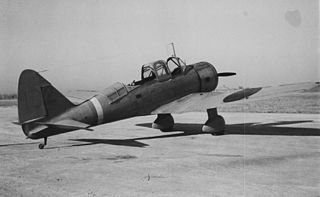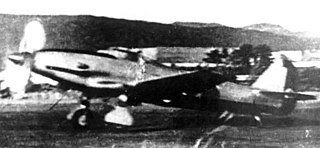
The Blohm & Voss BV 155 is a German high-altitude interceptor aircraft intended to be used by the Luftwaffe against raids by USAAF Boeing B-29 Superfortresses. Work started on the design as the Messerschmitt Me 155 in 1942, but the project went through a protracted development period and change of ownership, and prototypes were still under test and development when World War II ended.

The Kawasaki Ki-100 (キ100) is a single-seat single-engine monoplane fighter aircraft used by the Imperial Japanese Army Air Service (IJAAS) during World War II. The Japanese Army designation was "Type 5 Fighter". It was not assigned an Allied code name.

The Jumo 211 was a German inverted V-12 aircraft engine, Junkers Motoren's primary aircraft engine of World War II. It was the direct competitor to the Daimler-Benz DB 601 and closely paralleled its development. While the Daimler-Benz engine was mostly used in single-engined and twin-engined fighters, the Jumo engine was primarily used in bombers such as Junkers' own Ju 87 and Ju 88, and Heinkel's H-series examples of the Heinkel He 111 medium bomber. It was the most-produced German aero engine of the war, with almost 70,000 examples completed.

The Nakajima Ki-84 Hayate is a single-seat fighter flown by the Imperial Japanese Army Air Service in the last two years of World War II. The Allied reporting name was "Frank"; the Japanese Army designation was Army Type 4 Fighter. The Ki-84 is generally considered the best Japanese fighter to operate in large numbers during the conflict. The aircraft boasted high speed and excellent maneuverability with an armament that gave it formidable firepower. The Ki-84's performance matched that of any single-engine Allied fighter it faced, and its operational ceiling enabled it to intercept high-flying B-29 Superfortress bombers. Pilots and crews in the field learned to take care with the plane's high-maintenance Nakajima Homare engine and landing gear prone to buckling. The difficulties of Japan's situation late in the war took a toll on the aircraft's field performance as manufacturing defects multiplied, good quality fuel proved difficult to procure, and experienced pilots grew scarce. Nevertheless, a well-maintained Ki-84 was Japan's fastest fighter. A total of 3,514 aircraft were built.

The Daimler-Benz DB 601 was a German aircraft engine that was built during World War II. It was a liquid-cooled inverted V12, and powered the Messerschmitt Bf 109, Messerschmitt Bf 110, and many others. Approximately 19,000 601s were produced before it was replaced by the improved Daimler-Benz DB 605 in 1942.

The Daimler-Benz DB 600 was a German aircraft engine designed and built before World War II as part of a new generation of German engine technology. It was a liquid-cooled inverted V12 engine, and powered the Messerschmitt Bf 110 and Heinkel He 111 among others.

The Daimler-Benz DB 605 is a German aircraft engine built during World War II. Developed from the DB 601, the DB 605 was used from 1942 to 1945 in the Messerschmitt Bf 109 fighter, and the Bf 110 and Me 210C heavy fighters.

The Daimler-Benz DB 603 was a German aircraft engine used during World War II. It was a liquid-cooled 12-cylinder inverted V12 enlargement of the 33.9 Liter DB 601, which was in itself a development of the DB 600. Production of the DB 603 commenced in May 1942, and with a 44.5 liter displacement, was the largest displacement inverted V12 aircraft engine to be used in front line aircraft of the Third Reich during World War II.

The Kawasaki Ki-60 was an experimental Japanese pre-World War II fighter aircraft that used a license-built (Kawasaki) DB 601 liquid-cooled engine. This was, at that time, an unusual choice because the majority of Japanese aircraft at that time used air-cooled radial engines.

The Kawasaki Ki-32 was a Japanese light bomber aircraft of World War II. It was a single-engine, two-seat, mid-wing, cantilever monoplane with a fixed tailwheel undercarriage. An internal bomb bay accommodated a 300 kg (660 lb) offensive load, supplemented by 150 kg (330 lb) of bombs on external racks. During the war, it was known by the Allies by the name Mary. It was, however, mistakenly identified by the British as the Kawasaki Army KB-97 Mary.

The Henschel Hs 130 was a German high-altitude reconnaissance and bomber aircraft developed in World War II. It suffered from various mechanical faults and was never used operationally, only existing as prototype airframes.

The Tachikawa Ki-36 was a Japanese army co-operation aircraft of World War II. It was a two-seat, low-wing monoplane with a single piston engine and fixed, tailwheel-type undercarriage.

The Tachikawa Ki-77 was a Japanese very long-range experimental transport and communications aircraft of World War II derived from a design commissioned by a newspaper to break the flight distance record set by a rival. It was a low-wing cabin monoplane with twin piston engines and a tailwheel undercarriage.

The Aichi AE1A Atsuta was a Japanese licensed version of the German Daimler-Benz DB 601A 12-cylinder liquid-cooled inverted-vee aircraft engine. The Atsuta powered only two models of Imperial Japanese Navy Air Service (IJNAS) aircraft in World War II. The Imperial Japanese Army Air Service (IJAAS) used the same engine to power its Kawasaki Ki-61 Hien fighter. The IJNAS's Atsuta and its IJAAS cousin, the Ha-40 were based on the engine that powered Germany's Messerschmitt Bf 109E fighter.

The Breda Ba.201 was an Italian dive bomber designed during World War II, that never entered production.

The Caproni Vizzola F.4 was an Italian fighter aircraft prototype that was designed in 1937 and built from 1939. It was a single-seat, low-wing cantilever monoplane with retractable landing gear.

The Caproni Vizzola F.6 was a World War II-era Italian fighter aircraft built by Caproni. It was a single-seat, low-wing cantilever monoplane with retractable landing gear. Only two prototypes were built, one designated F.6M and the other designated F.6Z.

The Kawasaki Ki-64 was a one-off prototype of an experimental heavy, single seat, fighter. It had two unusual design features. First; it had two Kawasaki Ha-40 engines in tandem; one in the aircraft nose, the other behind the cockpit, both being connected by a drive shaft. This combination drove two, three-bladed, contra-rotating propellers. The second feature was the use of the wing surface as a radiator for the water-cooled engines. The aircraft first flew in December 1943. During the fifth flight, the rear engine caught fire; and while the aircraft made an emergency landing, it was damaged. The aircraft was subsequently abandoned in mid-1944 in favour of more promising projects. The airframe survived the war, and parts of the unique cooling system were sent to Wright Field for examination.
The Focke-Wulf Ta 254 was a proposed German development of the Ta 154 fighter, to have been produced by Focke-Wulf.

The Kawasaki Ha40, also known as the Army Type 2 1,100 hp Liquid Cooled In-line and Ha-60, was a license-built Daimler-Benz DB 601Aa 12-cylinder liquid-cooled inverted-vee aircraft engine. The Imperial Japanese Army Air Service (IJAAS) selected the engine to power its Kawasaki Ki-61 fighter.


















